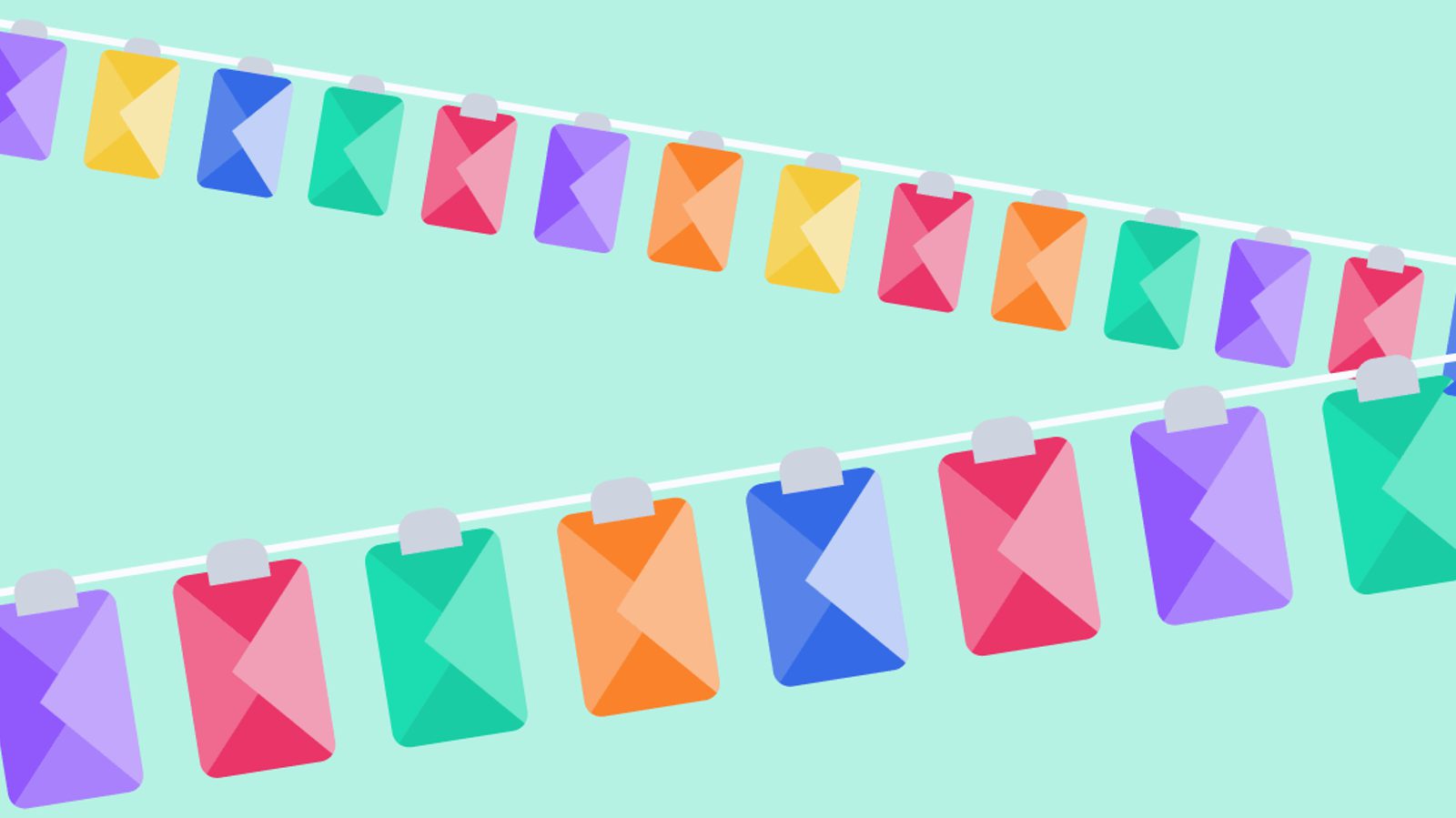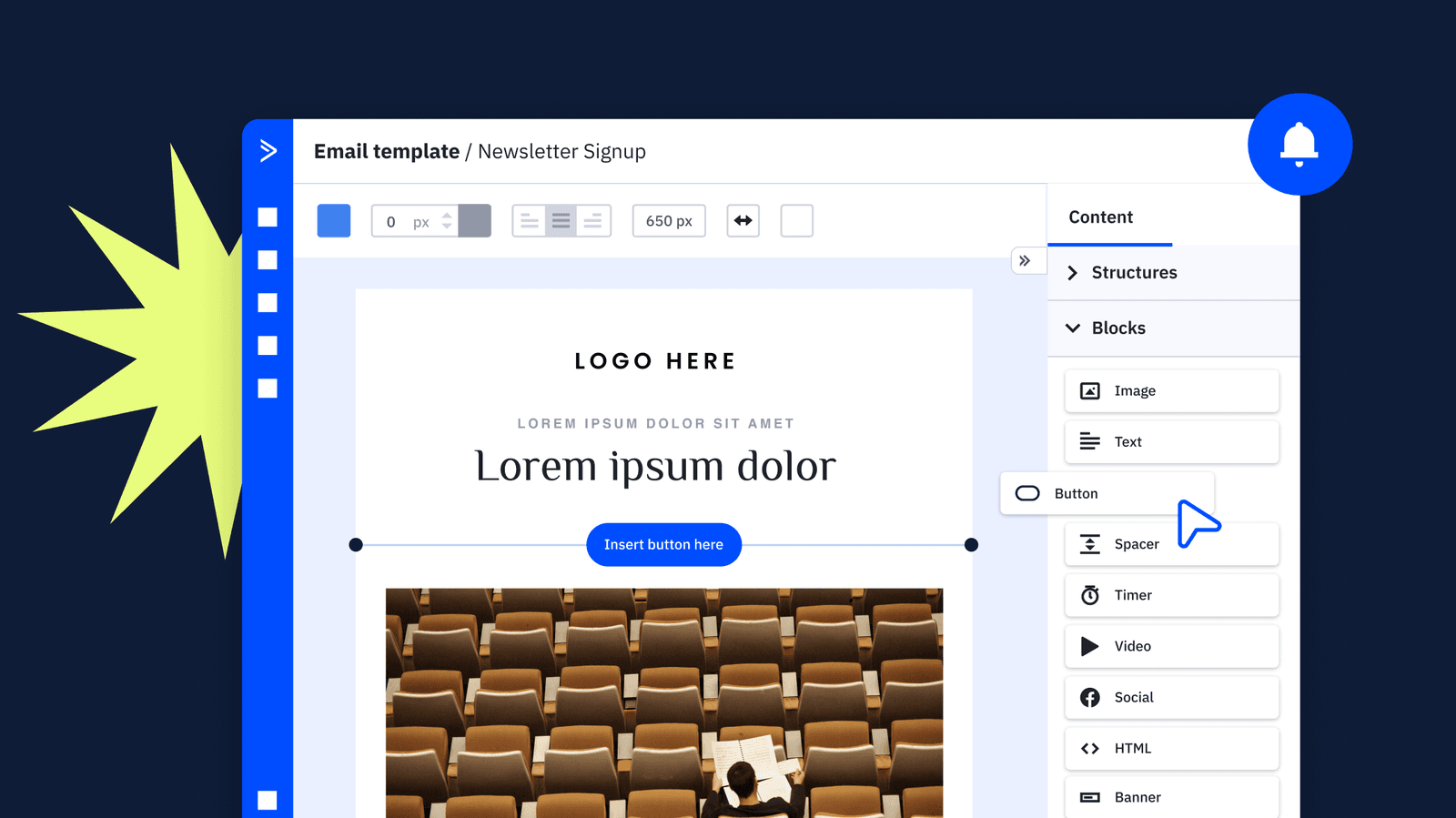According to the First Impressions Email Marketing Study conducted by Ciceron, only 39% of brands send a welcome email. Despite that, according to GetResponse, 8 out of 10 people will open a welcome email.
41% of brands didn’t send a welcome email within the first 48 hours after a subscriber joined.
And 27% sent zero emails in the first three weeks.
These welcome email statistics tell a compelling story.
You can put a lot of effort into your email newsletters and product launch automations. You can optimize your subject lines, preheader text, microcopy, and buttons. You can make sure to use bulletproof buttons and keep deliverability high.
All of that email optimization is important. But if you aren’t sending welcome emails, you’re missing an opportunity that blows all of them out of the water.
In this post:
- What is a welcome email?
- Why is a welcome email important?
- 6 ways to use welcome emails (and welcome email best practices)
- What goes into great welcome emails?
- 7 welcome email examples
What is a welcome email?
A welcome email is the first email that a new subscriber sees after they join your email list. Because it's the first email you send, it's your best chance to engage with your subscribers and show them your unique tone of voice.
When someone gives you their contact information, it's like a handshake. It's like they extend a hand and say “Nice to meet you, I’m [name]. I’ve heard a lot about you” Your welcome email is you reaching out for a handshake.

You don't want to have a weak handshake
It’s your first personal, one-to-one impression in the customer onboarding process.
That first impression can do a lot of different things. You can use it to increase sales, ask for referrals, get shares, point people to interesting content, help people get the most out of a purchase, or start a welcome series that leads up to a different goal.
Even if it’s just for your email newsletter and not trying to get sales—your welcome email it a huge opportunity. Make sure it does more than confirm a subscription.
There are a lot of confirmation emails out there that look like this:

I think I’ll be clicking that unsubscribe button now
Your welcome email doesn’t need to be one of them.
What’s the best way to send a welcome email? This…
7 welcome email examples
For some welcome email inspiration, here are 7 examples of good welcome emails that I think do a good job of illustrating the different jobs you can ask your welcome email to accomplish.
7 great welcome email examples:
- Copy Hackers
- Headspace
- Summer Tomato
- Airbnb
- Amazon Echo
- The Essential Man
- Platinum Skin Care
Welcome email example 1: Copy Hackers

Joanna Wiebe of Copy Hackers is an outstanding email copywriter. When you register for her weekly copywriting tutorials, she sends the above welcome email.
This welcome email example accomplishes a few things.
First, it confirms that you are registered for the tutorials. You want your welcome email to be more than just a confirmation email, but it does still need to confirm that people will get what they asked for.
Second, it takes advantage of high engagement. Welcome emails have a lot of engagement, so Joanna takes the opportunity to offer some relevant content.
Finally, knowing that Joanna is a believer in segmentation, I’d be surprised if she isn’t tagging her subscribers based on which link they click. Any information you can collect on your subscribers’ interests can be useful down the line.
Takeaways:
- Segment. Segmentation doesn't need to be complicated. Take every opportunity to collect information about your audience.
- Personality. Joanna could have just dumped links. Instead, she says "why not make a Nespresso and..." Use your welcome emails to showcase your personality.
- Give value. The links to popular tutorials help with segmentation, but they also deliver valuable, interesting content.
Welcome email example 2: Headspace

Source: Headspace via Really Good Emails
Headspace is a guided meditation app with a very distinctive brand style. The lead magnet for Headspace is 10 days of guided meditation, and you get this email when you sign up for it.
Simply put, this is a solid welcome email to new customers. It’s got some design, but it stays clean and clear. The design supports the message instead of overpowering it.
It has a clear goal and call to action, attempting to draw people into the app to start meditating.
And, lower down, it clarifies that the reader has 10 days of free meditation, and will need to subscribe to get more.
Takeaways:
- Call-to-action. When you need someone to engage with an app or product, make your welcome email CTA prominent and clear.
- Set expectations. The reader gets 10 free days of meditation, and this new customer email reminds them of that.
- Reinforce brand. Headspace is known for its doodles and cartoonish style. This email highlights that.
Welcome email example 3: Summer Tomato
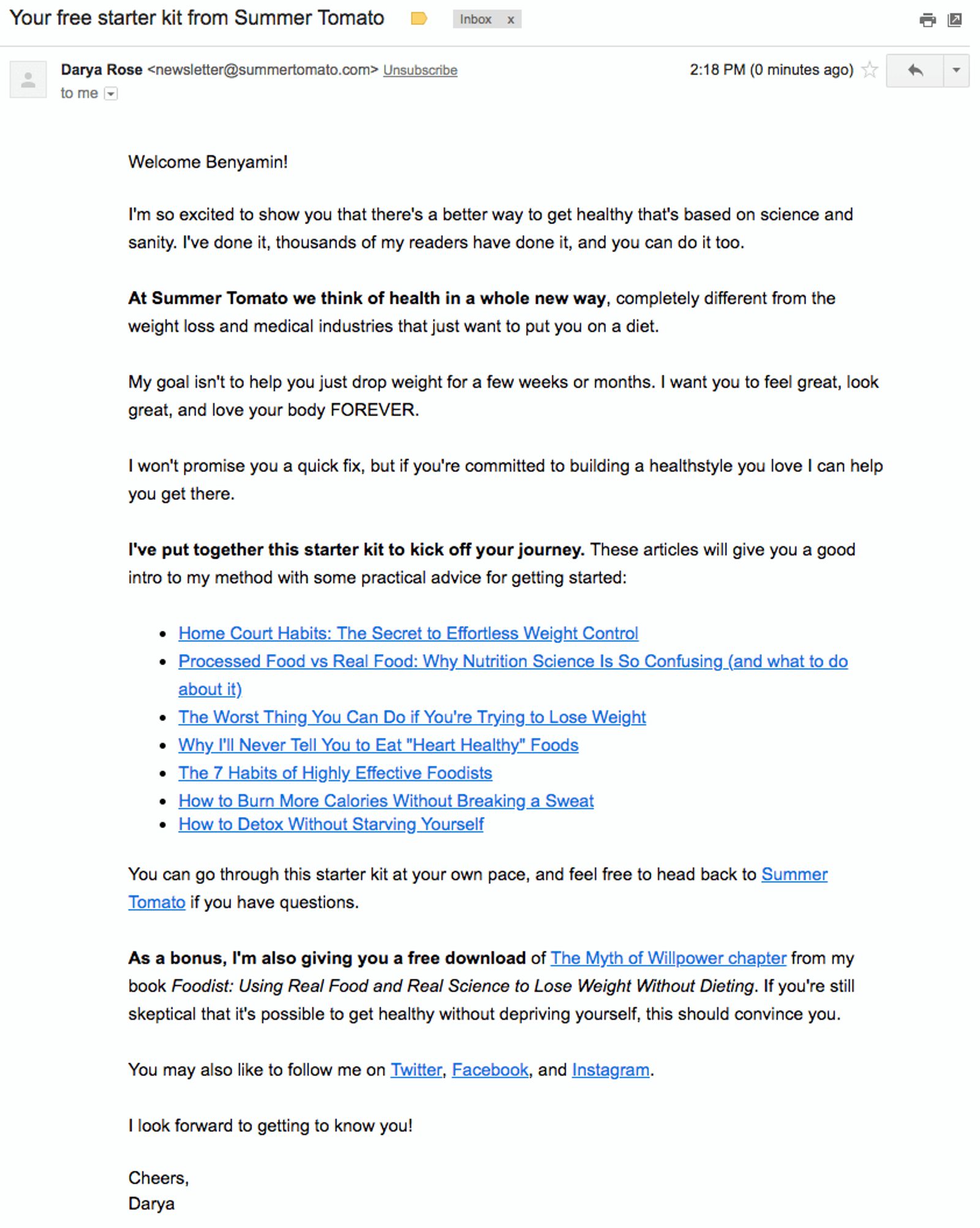
Darya Rose is a neuroscientist (yep, she’s got a PhD) who helps people lose weight without dieting. Subscribers get this welcome email after they request her “starter kit” lead magnet.
I like this email in part because of how simple the lead magnet it.
Darya realized that offering a lead magnet is much more compelling than asking people to subscribe to an email newsletter. Instead of going through a whole lead magnet design process, she pulled together some of her top blogs, branded them as a “starter kit,” and sent it in an email.
Brilliant. Perfect if you're low on time and resources.
This kind of email is also nice because the lead magnet itself offers people helpful content. It’s the first touchpoint to Summer Tomato’s brand and key differentiator, and subsequent emails in this automation build on her promise to “lose weight without dieting.”
Takeaways:
- Simple lead magnets are ok. If you don't know how to make a fancy ebook or video, a simple collection of resources can do the job. Check out these free welcome video script templates from Bonjoro for inspiration!
- Reinforce brand message. "My goal isn't to help you for weeks or months. My goal is to help you for YEARS." That's the value proposition of Summer Tomato, and Darya states it clearly.
- Credibility. Darya mentions thousands of readers, as well as sharing a chapter from her book. At this point, the reader knows she has a Ph.D., but these reinforce her credibility.
Welcome email example 4: Airbnb
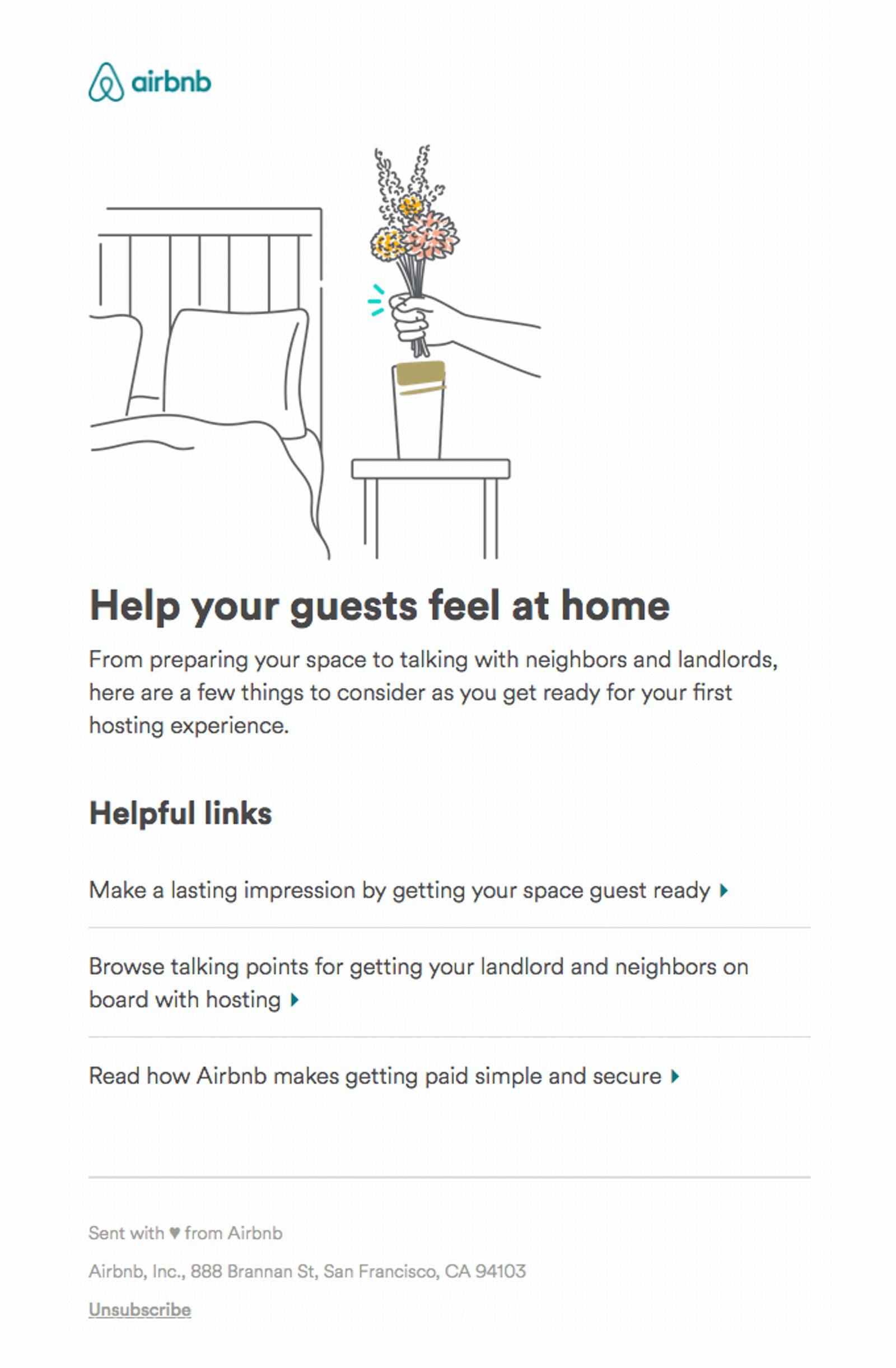
Source: Airbnb via Really Good Emails
Airbnb is well-known as a company, and this welcome email is a good example of something that has led to its success.
When you have strangers offering to give each other housing, there’s a real risk that the guest experience will be less than stellar. Airbnb works to prevent that by delivering this email after a listing is confirmed.
This is a confirmation email and a welcome email. It confirms that a listing is submitted, and delivers helpful links to help people give a better experience to their guests—which is better for guests, better for hosts, and better for Airbnb.
Takeaway:
- What's the goal of your welcome email? Airbnb wants people to have a great guest experience, so they support their hosts with useful content.
- Deliver useful welcome email content right away. You can customize the content that you send based on what you know about your subscribers. Airbnb would send a different email to a guest.
- Use all the space you have. This is both a confirmation email and a welcome email. Who said confirmation emails need to be boring?
Welcome email example 5: Amazon Echo

Source: Amazon via Really Good Emails
When I first got my Amazon Echo, I was excited. It could actually recognize my voice and answer my questions!
But eventually, I ran out of questions to ask. After some basics—What time is it?” “What’s the weather?” “How tall is Kareem Abdul-Jabbar?”—I started to lose interest.
In a brilliant example of getting people to use their product, Amazon sent over this welcome email for new customers: a list of new things I could ask Alexa.
Granted, I still mostly use my Echo in the morning, to check the time while my face is buried in a pillow. But this email helped me realize that I could use it for more than that.
And, in case you were wondering, Kareem Abdul-Jabbar is 7’2”.
Takeaways:
- Know what people want. Amazon wants people to play with their Echo and knows that after some basics (e.g. “What time is it?” “What’s the weather?” “How tall is Kareem Abdul-Jabbar?”) customers will run out of ideas.
- Give people what they want. Amazon sends along a list of ideas, knowing that the more people use their Echo, the more they will like it and tell their friends about it (and the more the smart home industry has the potential to grow).
- Mix business and pleasure. "Alexa help me sleep" is serious. "Alexa tell me a winter joke" is not. Humor is underused, but helps people connect to your brand.
Welcome email example 6: The Essential Man
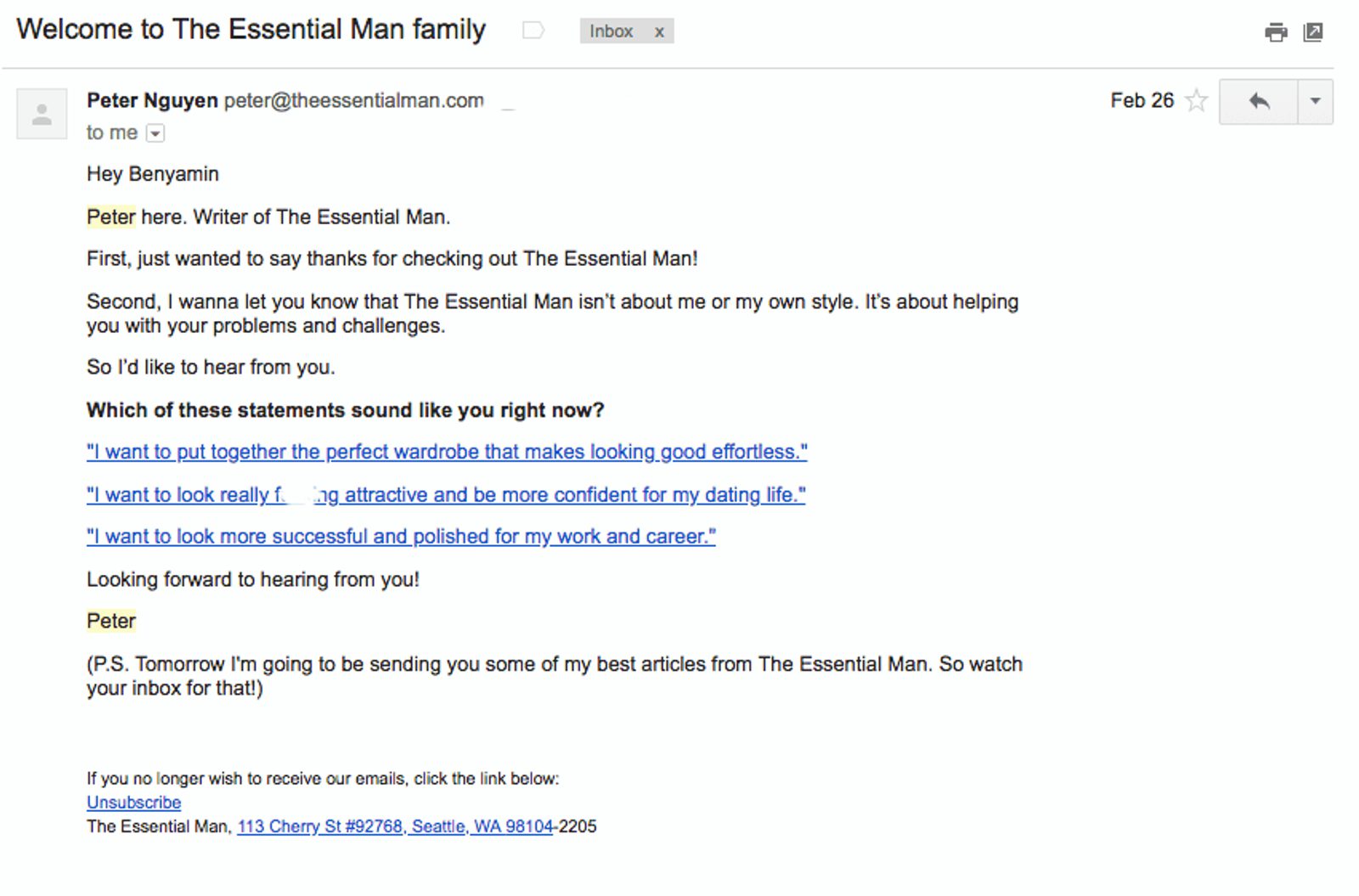
Peter Nguyen is a men’s style coach, who writes at The Essential Man. He helps young, professional men develop their own personal style without breaking the bank or drowning in clothes.
He also sends a great example of a segmented welcome email. Do his subscribers want to have better dates? Look more professional? Or just look good in general?
By sending three links and tagging people based on their clicks, he gets the answer right away—and has the ability to send targeted follow-up emails.
Takeaways:
- Segment! Like Joanna, Peter takes the first opportunity to segment his subscribers.
- Know what segments you attract. Notice that Peter has three separate value propositions. He's already done audience research to figure out what his different audiences care about.
- Tease the next email. Building anticipation ("Tomorrow I'm going to be sending you...") can increase email open rates for your second welcome email.
Welcome email example 7: Platinum Skin Care
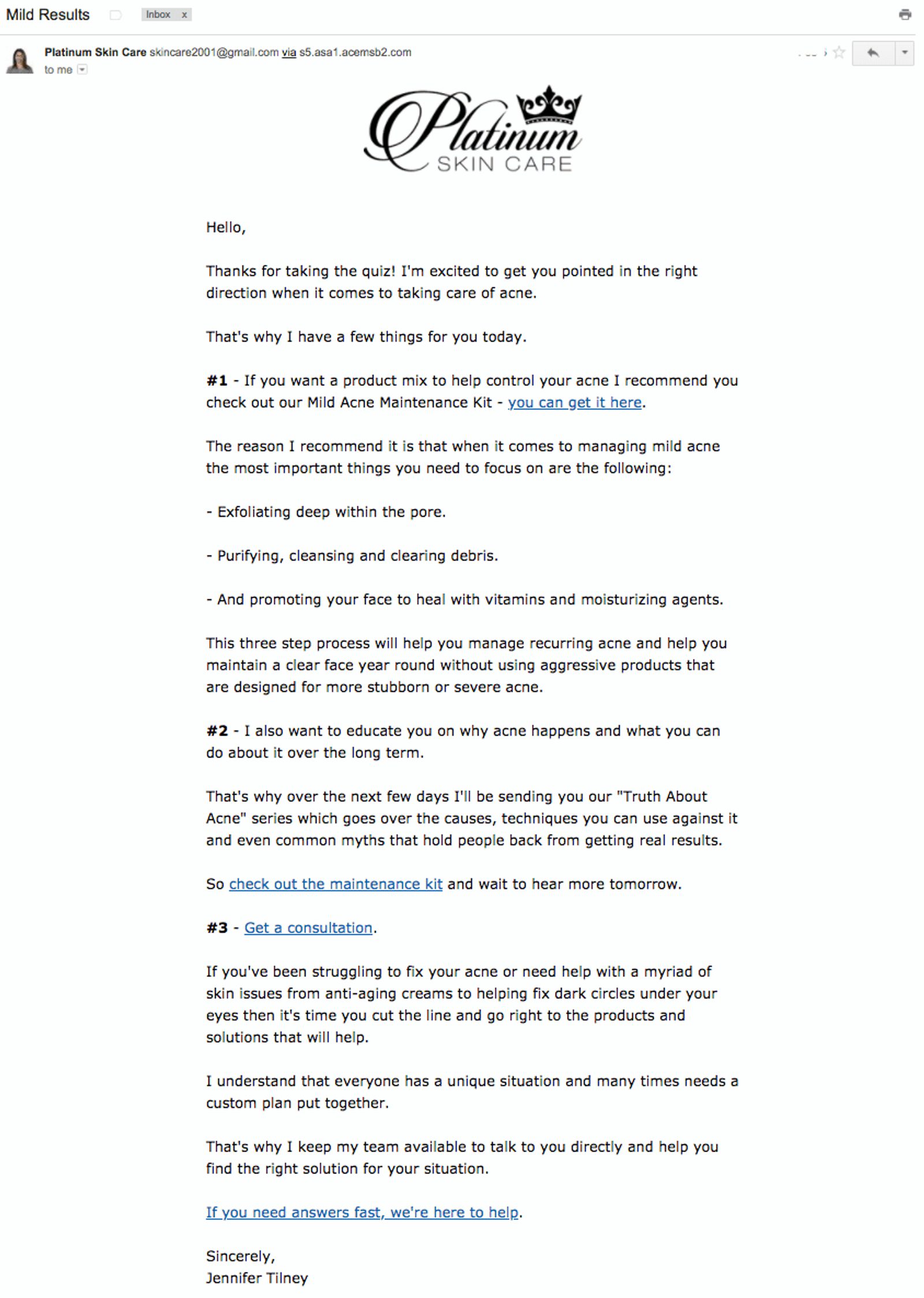
Platinum Skin Care does great email marketing. What makes Platinum Skin Care different from the other great welcome email examples on this list is that they use a quiz as their lead magnet for subscribers.

This quiz lets Platinum Skin Care collect contact information, but it also lets them segment subscribers before they even get an email.
Does someone on a skincare site want to improve dry skin or fight acne? It could be either, so Platinum Skin Care uses the quiz for segmentation—then immediately follows up with a product recommendation unique to each person’s results.
At the same time, not everyone who completes an online quiz is ready to buy. This welcome email is the first in a series, where each subscriber gets helpful skincare tips based on their results from the quiz.
It’s a brilliant approach to email segmentation that makes Platinum Skin Care’s welcome email all the more powerful.
Takeaways:
- Segment! Are you sensing a theme? Platinum Skin Care is a great example because they actually manage to segment before the welcome email.
- Target your welcome email content. The welcome email and automated follow-up email are customized based on the results of the quiz (and each subscriber's needs).
- Don't be afraid of text! It's important that people know what you stand for. Especially after going through a high-engagement lead magnet (like a quiz), your subscribers will be eager to hear from you.
Why is a welcome email important?
Do welcome emails work? Yes.
Your welcome email is your best chance to engage new contacts. Aside from being your first chance to make a good, personalized impression, a welcome email is your best opportunity to get people to take action.
New contacts want to hear from you!
Open rates and clickthrough rates are almost always the highest on welcome emails. It’s your best chance to reach a new contact and get them to engage with you—whether that means reading a blog post or getting ready to buy a product.
Here’s a screenshot from the report for the welcome email from one of my blog posts.
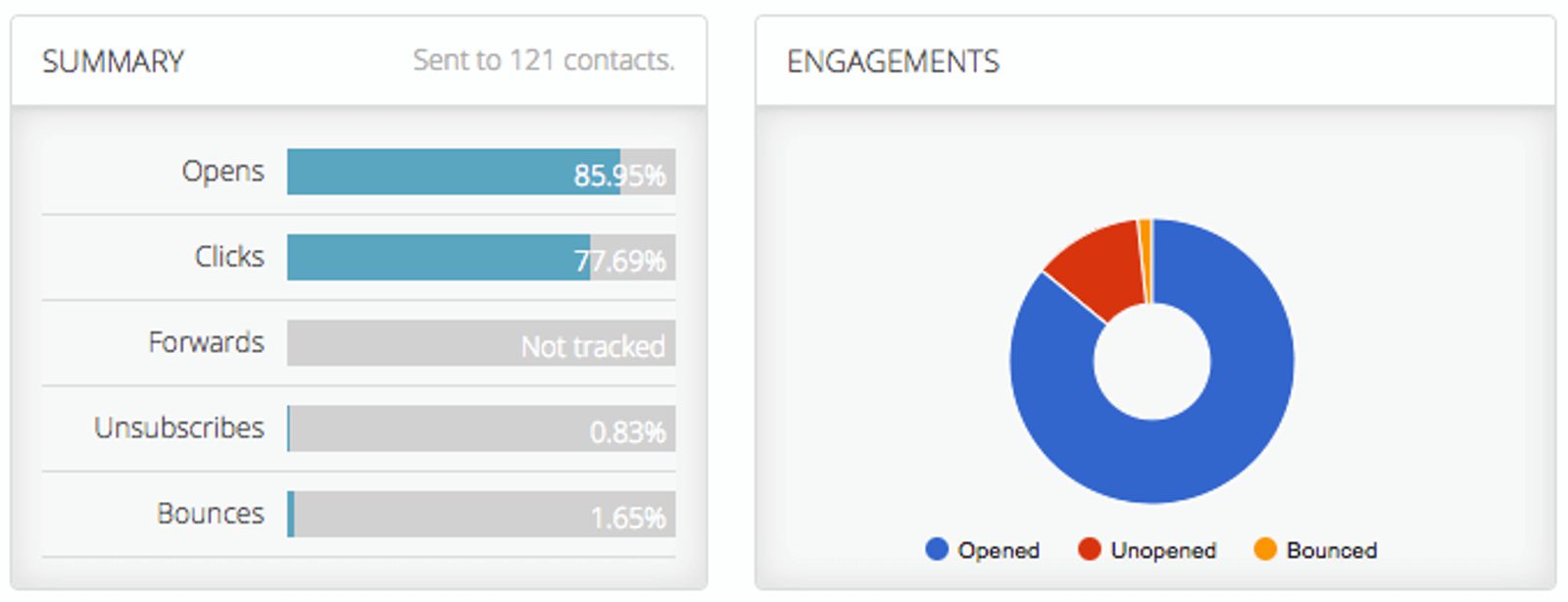
That's a click-to-open rate of 90%
An 85% open rate! 77% clickthrough! That’s a click-to-open rate of 90%. I wish my sales emails got that kind of response.
New contacts are the contacts most likely to say yes to your call to action. They are excited. They are expecting you to email them right away.
If you don’t send a welcome email, you’re missing that opportunity.
Expert insight: Andy Crestodina on welcome emails

“There's one email that gets a higher open rate than all others: the welcome-to-my-list email.
It's no surprise. The recipient is at their peak interest. They just converted into a subscriber, so they are want your content and trust your brand. Setting this auto-response it a no-brainer. Opens and click through rates are often 2x any other emails you send.
Think of it as just being polite. When someone starts listening, you should say hello, right? When someone asks for more, give them your best. I think of the welcome series as both smart marketing and common courtesy.”
– Andy Crestodina is a marketing expert, thought leader, and co-founder of Orbit Media Studios. He's an expert in SEO, web design, and using data to guide marketing strategy.
6 ways to use welcome emails (and welcome email best practices)
You know that your welcome email needs to have more information than just a subscription confirmation. But what can you put in a welcome email?
Even once you know that a welcome email is your best chance to get engagement from your new email subscribers, there are other questions that need to be answered.
- "What should I write in my welcome email?"
- "Should I have a call to action?"
- "How do I know if my welcome email is working?"
Those questions start to get answered when you think past the tactic.
What do I mean by that?
Instead of thinking "I should send a welcome email because welcome emails get a lot of engagement," ask yourself—what value does a welcome email bring to your business?
How can you use this tool to achieve your broader business goals?
Aren’t you curious what our welcome email looks like?
Here are 6 common ways to use a welcome email — and some welcome email best practices.
- Lead magnet delivery
- A pitch for a product
- Start a welcome email series or welcome campaign
- Get people to use your product with onboarding welcome emails
- Give people helpful information
- Segment your audience
1. Lead magnet delivery
If you promised to deliver a lead magnet, the welcome email is the time to do it.
This might be the simplest use of a welcome email because people are expecting the lead magnet they were promised.
I once got a lovely email from a kind new subscriber that read “Dude, you suck at marketing. [expletive] you and [expletive] your site. Deliver what you say you will deliver.”
Unbeknownst to me (or, apparently, him), my lead magnet was being delivered to the Promotions tab of Gmail.
He eventually apologized—but the lesson is that people expect you to deliver on your lead magnets.

How can you deliver a lead magnet? A good email marketing or marketing automation service makes lead magnet delivery simple. In ActiveCampaign, for example, we have pre-made automation that you can use to deliver as many different lead magnets as you like.
Once you’ve delivered a lead magnet, there’s still more you can get out of this first email. For more welcome email ideas, read on.
2. A pitch for a product
Your welcome email is likely to see the highest open rates of any email you’ll ever send. For that reason, it might not be a bad time to pitch a product.
Here's a great welcome series example: Online business coach Graham Cochrane used to run a welcome email series that led to a free webinar and sales pitch. As he shared on GrowthLab, he was able to get an 89% increase in sales by moving the call to action for his webinar immediately after someone subscribed.

Source: GrowthLab
Here are the exact steps of Cochrane's email funnel, as he wrote about them on GrowthLab (in this context, a "carrot" is a lead magnet).
"This is the new funnel:
- Sign up for carrot (100%)
- Taken to a “Thank you” page, emailed PDF download, invited to a webinar
- Sign up for a webinar (20%)
- Attend webinar (10%)
- Get pitched product
- Buy product
$24,759 / month avg."
(That number is compared to his previous average of $13,101 / month).
This is often a good play for e-commerce businesses. If you know that products are related or frequently bought together, including a CTA or temporary coupon for related products can help a customer become a repeat customer.
Jordan Skole made this point during an ActiveCampaign live AMA:
"When someone buys one of my products, that gives me a sense of what else they might be interested in. What else do people who get the product usually buy? I can segment based on that information to make a targeted offer."
Your welcome email isn’t always the right time for a pitch—some people will need more time before they’re willing to buy. A quick sale may also be more difficult if you sell high-priced products, where buying cycles are typically longer.
Still, including a sales pitch in your welcome email is absolutely worth testing.
3. Start a welcome series or welcome campaign
A welcome series or automated follow-up sequence can help you nurture leads that aren’t ready to buy immediately.
A welcome series is a simple type of marketing automation. This video, from the free course Getting Started with ActiveCampaign, gives you some good ways to get started with organizing your automations.
One of my favorite parts about Grant Cochrane’s new webinar pitch is that the subscribers that don’t register for his webinar still go through his normal welcome series—so he has two opportunities to convert them.
A welcome email series can have as many goals as there are types of businesses.
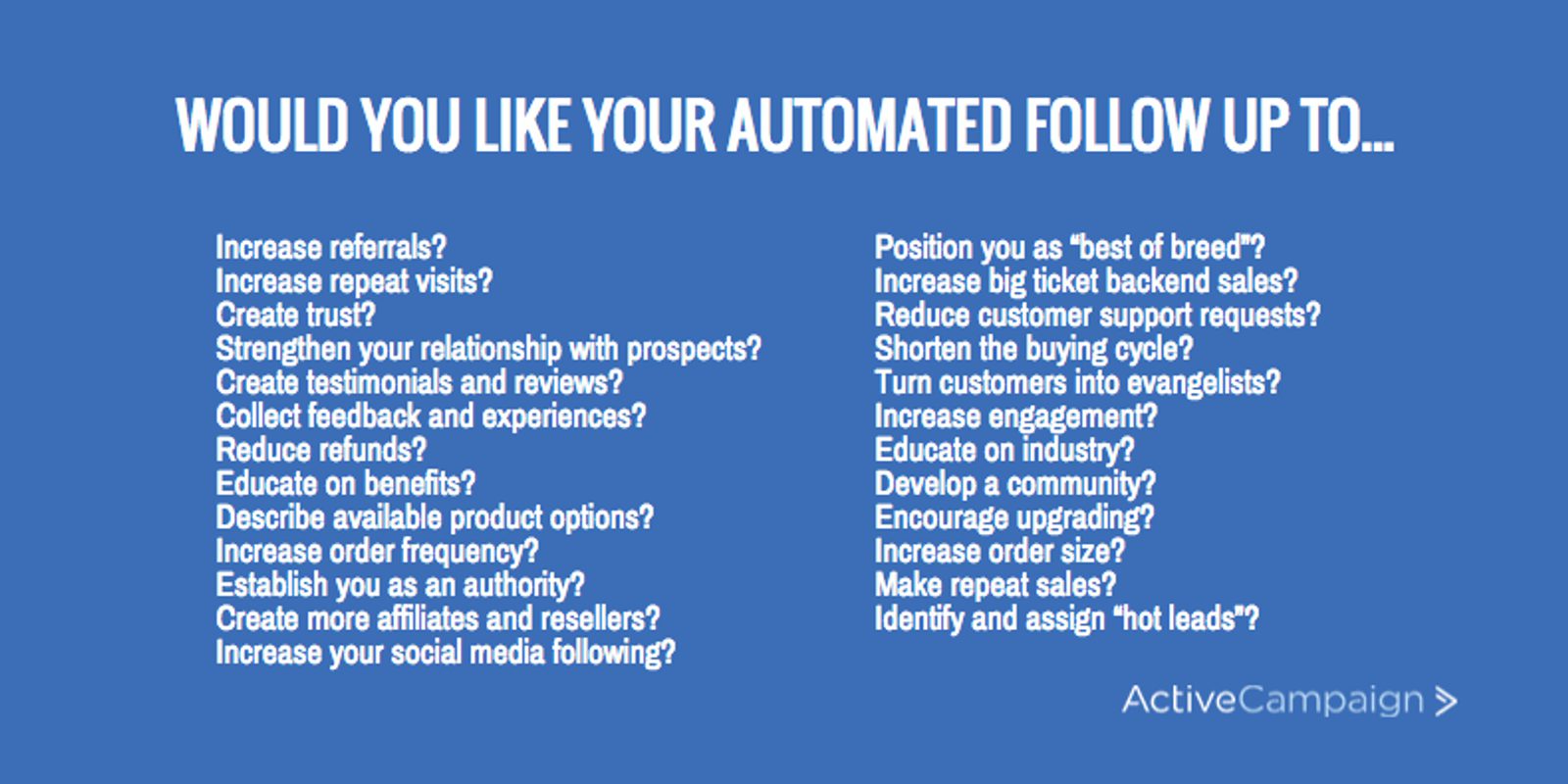
A few possible goals for a welcome series
A service-based business might deliver targeted welcome content that builds trust and demonstrates expertise. An e-commerce business welcome email can share tips to get the most out of a product. A SaaS business welcome email can try to get people to click around in their app. And a lot of online businesses use a welcome series to sell an information product or course.
Expert insight: Joel Klettke on welcome email next steps

One of the most important things you can do in a welcome email is give people a clear picture of next steps.
What's the ONE small step they can take RIGHT NOW to become a more successful user? What tiny little forward motion could help push the snowball down the hill?
Make sure that whatever you offer as a next step, it is easy, attainable, and moves them toward their "AHA" moment of being a user or subscriber.
– Joel Klettke is a conversion copywriter. He is the founder of Business Casual Copywriting and Case Study Buddy.
Because there are so many potential ways to use a welcome email series, we wrote an entirely separate article on the subject. You can read it here: 7 Steps to Create Your Best Automated Follow-up Sequence.
4. Get people to use your product with onboarding welcome emails
If you run a software company or have an app, you want people to get into using your product as quickly as possible. The faster they reach their “aha” moment, the more likely they are to stick around.
Even if you aren't in tech, onboarding welcome emails could still be important.
If you run an online course or a membership site, you know that it can be tough to get people to stick around. An onboarding series:
- Gets people to engage with your product right away
- Reduces "analysis paralysis," by showing your customers some quick wins
- Results in more people finishing your courses (and more people recommending you to friends)
For those reasons, an account welcome email often includes a call to action to bring readers back into your app or product.
This type of email is in the list of welcome email examples below.
5. Give people helpful information
Maybe you aren’t selling anything yet, or you sell a product/service with a very long buying cycle—one that people aren’t likely to buy right away.
Maybe you want to make sure your customers get the most out of a product they’ve purchased.
Sometimes, your goal is to give your subscribers information. Welcome emails are a good opportunity to deliver content that helps nurture subscribers.
When is it important to send content in your welcome emails? What welcome email content can you send?
- Send content related to the specific lead magnet someone downloaded
- Use content to automate sales emails that you would normally send by hand
- For long buying cycles, use content to start building trust with new subscribers
The links in these new customer welcome emails can also be used to segment your audience.
6. Segment your audience
Sometimes you can tell what brought a new contact to your list based on what lead magnet they downloaded or what page they subscribed from.
Other times, when you serve multiple audiences, you might not be sure which audience a new contact falls under.
What do you do? Ask them to self-segment. You’ll see some examples of these in the emails below.
To do this, include a set of links in your welcome email. Offer a set of links that address different pain points for different audiences. When someone clicks on a link, add a tag so you know who they are. You can even have this trigger a new automation.
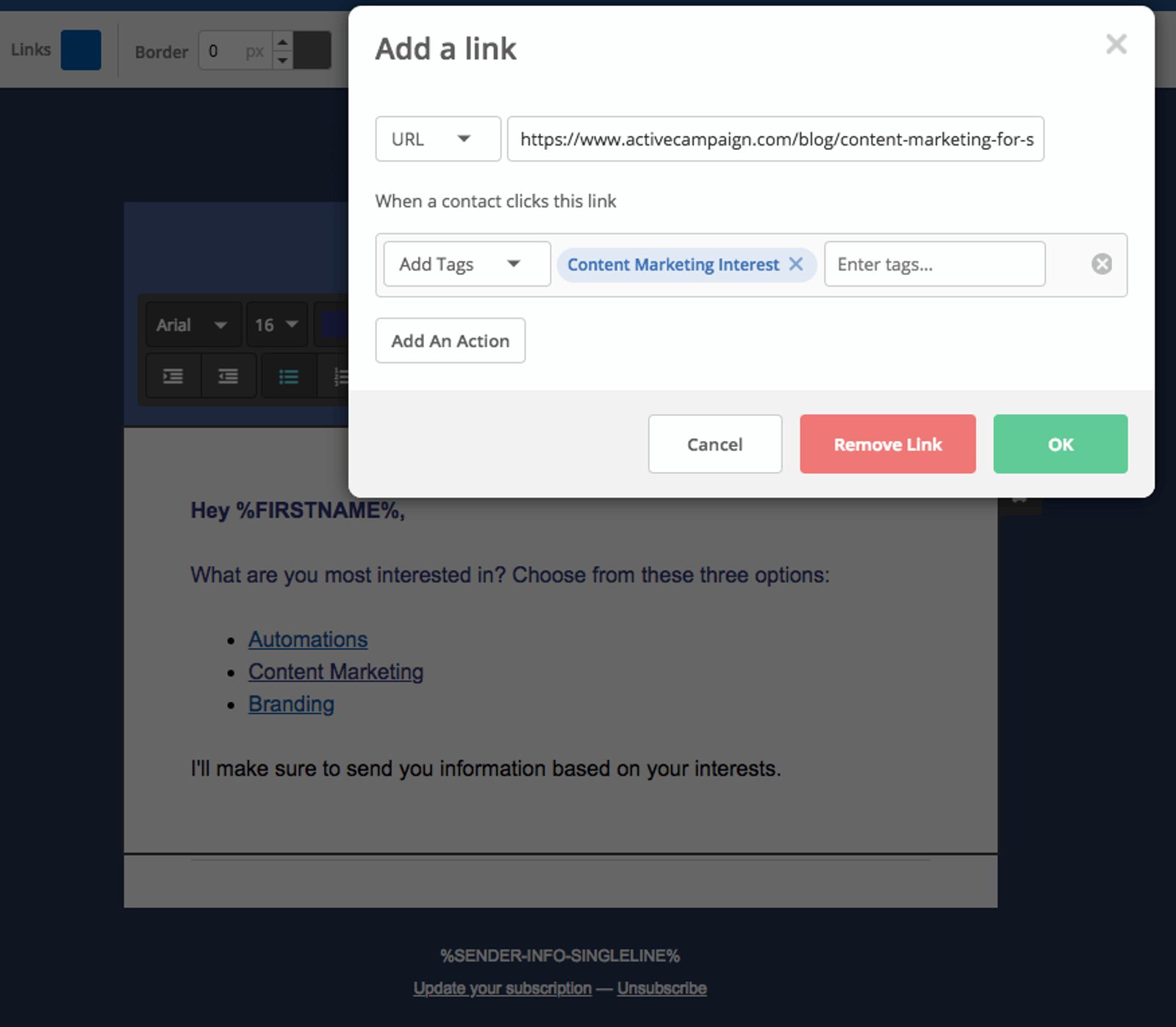
I whipped up this quick example to illustrate the point. In this bare-bones sample email, I ask people to choose what they’re most interested in: automations, content marketing, or branding. When they click the link, I add the relevant tag.
Email segmentation helps you send the most relevant content and offers to your contacts. The sooner you can segment your email list, the more opportunities you have to send targeted content.
What goes into great welcome emails?
To better create your best welcome email for your customer onboarding flow, knowing what a welcome email can accomplish is a good start—but what makes a great welcome email great to begin with?
Only 39% of brands are sending welcome emails. You have to imagine that the percentage of brands sending good welcome emails is even lower.
Expert insight: Val Geisler on the best welcome emails being welcoming

"A welcome email should do just that: welcome your reader. It should be the beginning of building a relationship, not a sales pitch or a push for your product.
Think about when you go shopping and there's someone there greeting you right when you walk in the store. If they say "Hi! We're having a sale and I think you'd look great in this shirt and it's 50% off so I'll just put it in a fitting room for you okay?" it's a jarring experience. You just walked into the store!
Contrast that with the same salesperson saying "Hey, welcome! It's pretty hot out there today, isn't it? I'm Miranda, by the way. I'm here if you need anything as you look around." Quite the different experience. The second welcome makes you feel seen and human, the first makes you feel like a walking wallet.
Your welcome emails should aim to make your readers feel seen and human too. Lead with a warm welcome and save the sales for later on in your customer onboarding."
– Val Geisler has been called an email geek, a copywriter, a marketer, and a real game changer (but you can just call her Val). You can learn more about email copywriting and email marketing strategy on her website.
Here are some things to keep in mind.
Beautiful welcome email design is less important than a usable welcome email design
No, I’m not saying you should send ugly emails. But too often, businesses spend a lot of time on welcome email templates and design—and not nearly enough time deciding what actually goes in their welcome emails.
Consider your higher-level goals. What action do you want people to take? What do you want people to feel?
You may find that a beautiful welcome email design is important to your goal. You may also find that text-based emails are totally enough to accomplish your goals.
Email subject lines, from names, and preheader text matter
Once you know what welcome email content you want to send, your overall message, and your goals—then you can worry about details like welcome email subject lines and names.
And they’re worth worrying about. Open rates for welcome emails are usually high, which is good. But a good subject line can help you reach even more people. It can even be so compelling that it gives you a boost to your clickthrough rate.
Here are some quick email best practices to help you increase open rates:
- Make your “from” name a real person (not a company name and certainly not “Do Not Reply”)
- Add meaningful preheader text. That’s the preview of the body of your email.
- Write a compelling welcome email subject line
Here’s an example from Andy Crestodina of Orbit Media (who also has a good blog post on how to increase email open rates):

The email comes from a person. I like the inclusion of a company name since it reminds the recipient why they’re getting the email. There’s social proof in the headline, and the preheader text isn’t gibberish.

For comparison, here’s an email where the preheader text could use some work.
Great preheader text builds curiosity and entices people to click. If you don’t consciously update your preheader text, it will often default to showing the beginning of your email.
Clear welcome email CTAs
Unlike a lot of emails, your welcome email doesn’t necessarily need to have only one call-to-action (CTA). (It should probably have at least one though.)
But it does need to have one goal.
Whether that goal is to get people to self-segment, entice people back into your app, sell a related product, or provide useful information, clear CTAs will help you increase conversions and track success.
Conclusion: How to write a great welcome email
To send a great welcome email, you need to have a great understanding of your own goals and your subscribers’ needs.
What can a welcome email do for you?
- A welcome email can double as a confirmation email
- It can send targeted, useful content
- It lets you segment your audience
- You can use it to pitch your products
- It reinforces your brand and tone of voice (use these email templates to stay on brand!)
When you understand your goals, focus on providing value, and focus on email marketing fundamentals, you can create a welcome email that works harder than a simple confirmation.

